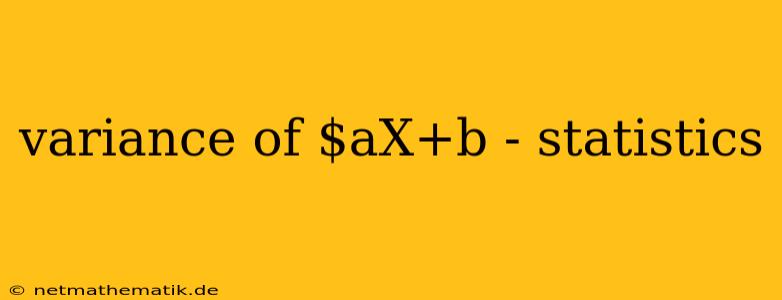In the realm of statistics, understanding the variance of aX + b is crucial for analyzing and interpreting data. This concept helps us determine the spread or variability of a transformed random variable, derived from the original random variable X. The transformation involves multiplying X by a constant 'a' and adding another constant 'b'. This article will delve into the essential aspects of the variance of aX + b, exploring its mathematical foundation, practical applications, and its significance in statistical analysis.
Understanding Variance
Before delving into the variance of aX + b, let's first grasp the concept of variance itself. In statistics, variance quantifies the spread or dispersion of a set of data points around the mean. A higher variance indicates a greater spread of data points, while a lower variance signifies a tighter clustering of data points around the mean.
Mathematically, the variance of a random variable X, denoted as Var(X), is calculated as the expected value of the squared difference between X and its mean (µ):
Var(X) = E[(X - µ)²]
Here, E represents the expected value operator.
The Effect of Linear Transformations on Variance
Now, let's consider the transformation of a random variable X to aX + b, where 'a' and 'b' are constants. How does this transformation affect the variance?
The variance of aX + b, denoted as Var(aX + b), can be calculated using the following formula:
Var(aX + b) = a² Var(X)
This formula reveals several key points:
-
Scaling Effect: Multiplying X by a constant 'a' scales the variance by a² (the square of the constant). This means if 'a' is greater than 1, the variance increases, and if 'a' is between 0 and 1, the variance decreases.
-
Shifting Effect: Adding a constant 'b' does not affect the variance. This is because shifting the data points by a constant value does not change the spread of the data.
Application of Variance of aX + b
The concept of variance of aX + b finds numerous applications in various fields, including:
-
Financial Modeling: In finance, it is used to analyze the risk associated with investments. For instance, the variance of the return on a portfolio can be calculated by considering the variance of individual assets and the correlation between them.
-
Quality Control: In manufacturing processes, the variance of aX + b is utilized to monitor product quality and identify potential variations in production.
-
Machine Learning: In machine learning algorithms, understanding the variance of features is essential for model optimization and avoiding overfitting.
Illustrative Example
Consider a random variable X representing the height of students in a class. The mean height is 5 feet, and the variance is 0.25 square feet. Now, suppose we want to convert the heights to centimeters using the transformation aX + b, where a = 30.48 (conversion factor from feet to centimeters) and b = 0.
Using the formula for variance of aX + b:
Var(aX + b) = a² Var(X) = (30.48)² * 0.25 = 232.25 square centimeters.
Therefore, the variance of the heights expressed in centimeters is 232.25 square centimeters.
Conclusion
The variance of aX + b is a fundamental concept in statistics that helps us understand how linear transformations affect the spread or variability of random variables. This concept has significant applications in various fields, including finance, quality control, and machine learning. By understanding the scaling and shifting effects of linear transformations on variance, we can gain valuable insights into the distribution and variability of transformed data. The ability to analyze the variance of aX + b is crucial for making informed decisions and drawing meaningful conclusions from statistical data.
